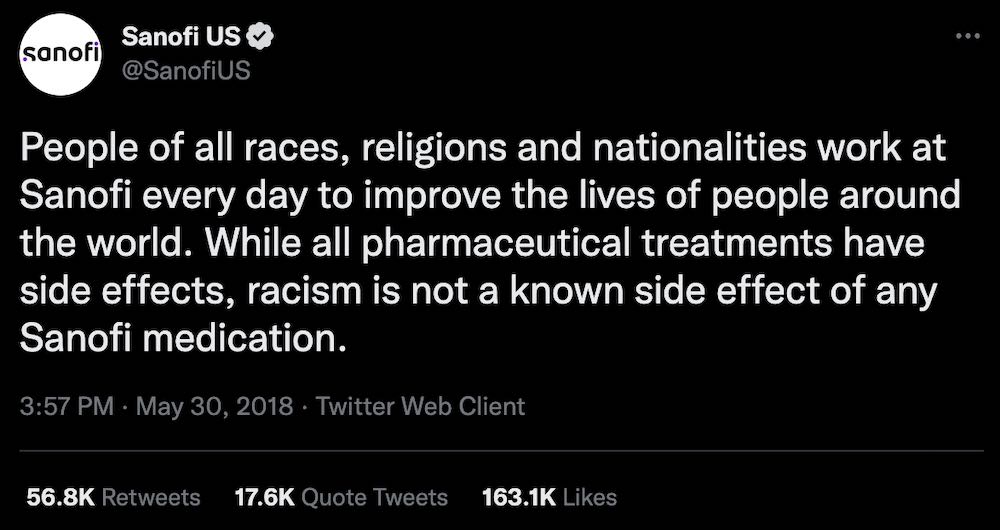The pharmaceutical world is peculiar and “suffers” from a relatively bad image globally.
A pre-covid report from 2018 stated that only 2% of pharma-related posts on social media had a positive sentiment (11% were negative and 87% were neutral).
In fact, the most popular hashtags related to the industry were #corruption and #bribery. Ouch.
Then COVID happened and interestingly, it had a positive impact on pharma’s image overall. The pandemic brought the pharma industry into the spotlight, praising its quick reaction to develop vaccines.
But while this might be THE opportunity for the pharma industry to reset its reputation, it might as well just be a poisoned gift…
If not leveraged properly, this upturn in reputation could be short-lived and any consequent shadow in the spotlight could leave the industry’s image worse off than before COVID, as people’s expectations are now higher.
That’s why taking proper care of your brand’s image on social media is more important now than ever.
Here is how pharma marketers can leverage the upturn by working on their brand image and generating positive engagement through social media.
Key takeaways
Turn your employees into brand advocates
Social listening is key to measuring your brand’s sentiment on social media, but what can actually be done to improve that image?
Don’t miss our in-depth guide on social listening in pharma
Of course, it’s case per case, but a practice that more pharma brands should follow is employee advocacy.
Some pharma organisations prefer not to take that step because of compliance, but trust us, the juice is worth the squeeze!
According to Linkedin, only 3% of employees share company content with their community, but the content they share sees a 30% increase in social media engagement.
Consider this: what better brand advocates than the people that work there?
Not only does this give a more human side to the brand, but it also increases patient trust and engagement (even though regular employees have been losing credibility since COVID).
Actionable tips on how to develop employee advocacy
Don’t just ask employees to be brand advocates, first explain the impact they can have
Linkedin is a good place to start. Employees may not be ready to share work-related content on Facebook or Instagram as they keep these platforms to interact with friends, but Linkedin being a professional platform, they might be more open
Give them a social media crash course. Employees don’t especially know how to use social media correctly and they are often afraid to share content the wrong way
Don’t let compliance stand in the way. Have the compliance team design SOPs with clear guidelines and examples of what can and can’t be shared, for each platform. Train the team on it and re-train them on a yearly basis
Send shareable content suggestions to employees (in a non-intrusive way) to save them some time. Again, some employees might want to be advocates but don’t know what to share
Give them incentives. Pharmaceutical-related content is sensitive content to share and employees ready to do so should be rewarded or incentivised
Share employee stories, where employees share why they work for the company and why they love it. These stories give a positive image to the company and humanise the brand, plus your employees will probably gladly share the stories on their own accounts as well
Humanise your brand
Social media are maybe the most powerful tools pharma marketers can use to humanise a brand and work on its image.
We go through many pharma companies’ social media profiles and while we feel like this is something a lot of these companies understand already, there is still room for improvement; especially since brand humanisation is a key ingredient to a successful social media strategy.
How to use social media to humanise your brand
Time to open up! Share stories about your team, show what’s going on behind the scenes,… and don’t forget to include real images. This brings both authenticity and transparency
It’s not all about pharma. Communicate about your company’s values and the social issues you are taking a stand for. If LGBT support is a focus for your company, share it on social media AND involve the employees (quote, photo, stories…)
Get the CEO and senior leadership to speak up and take a stand on what they stand for. They play a huge role in building a brand’s image, especially by stakeholders and HCPs
Show the faces of your employees. This shows the public that your pharma company is not just “a big corporation making a profit on people’s illness”. Happy, involved employees create empathy
Even better, involve your employees. As we said in the section above, employees’ engagement on social media is a must-have to build trust
Give patients and caregivers a voice. Patients trust other patients and having them support your brand, through quotes or short video stories, for example, is key to building trust
Take time to get involved in real-time conversations by answering comments or even better, through live streams. This is not only a great way to engage with consumers and to let them feel heard, but it’s also about showing that your company is a human-sized business
Videos are powerful. Video content is better to grab attention, it gets more engagement and drives more conversions (94% of social media users say that videos are important in their decision process). But it’s also more flexible than images to build trust and create a deeper connection with your audience
The main trap to avoid is to take the easy way out when applying these tips. It can be tempting to resort to stock images or models, but that would be missing the point.
Humanising a brand is about being human-centric, but it’s also about conveying emotions. Stock images might fool a few but these images often just feel manufactured and unauthentic.
Social media is another string to your PR bow, but don’t let it misfire!
Social media is a great communication tool that allows for near real-time reaction, either to help a follower or to “fight” misinformation that could hurt your brand. But this instant reach can be a double-edged sword if not dealt with properly.
Let’s go back to 2018 for a great example of how a pharma company took advantage of social media to deal with PR issues.
Long story short, an actress posted a racist Tweet and then blamed Ambien (Sanofi’s drug against insomnia) for it. Instead of ignoring the Tweet, Sanofi’s team decided to respond on Twitter.
They did it fast and effectively, not letting any chance for the Tweet to hurt their image.
Here is their answer: “People of all races, religions and nationalities work at Sanofi every day to improve the lives of people around the world. While all pharmaceutical treatments have side effects, racism is not a known side effect of any Sanofi medication.”

This tweet generated 57K Retweets, 17.6K Quote Tweets, 163K likes and plenty of positive comments.
Hats off!
Now, that was a clever answer and even though the post still had to go through compliance reviews before posting, they were very reactive.
However, this is a textbook-level example and there is countless faux pas from brands on social media. And the thing with these platforms is that “mistakes” or faux pas can escalate quickly and turn into PR disasters.
If Sanofi’s social media manager would have lost his cool when replying to that actress, things could have easily gone bad and hurt Sanofi’s image, even though the actress’s claim was baseless.
How to avoid your own PR disaster on social media
Set clear guidelines: Whoever is in charge of your social media accounts (or has access) needs clear guidelines on what to post and how to react on social media. Both the marketing and compliance teams have to be involved in the definition of the guidelines
Create a crisis plan: Things can go wrong and mistakes happen (poor press from external media being shared on social networks, unintentionally bad timing for a post,…). What matters is that when a crisis happens, your team knows how to react in case of escalation. This includes:
- Own your mistakes: People appreciate an apology and while it doesn’t fix everything, it shows your audience that you’re human as well, after all
- Don’t ignore comments: Comments and callouts shouldn’t be ignored as it will just give these comments more credibility and you don’t want to risk an unanswered comment going viral
- Don’t be rude: It might sound obvious, but comments can be harsh and it’s important not to take it personally, as offensive or baseless as these comments can be. Don’t attack the commenter on a personal level and keep your answer polite and helpful
- Bring the conversation offline: When possible, encourage the person to resolve the matter offline, for two reasons: this keeps the argument away from the public’s eye and people often lose their anger once there is no screen to hide behind
- Don’t remove posts or comments: Removing comments gives the same impression as unanswered comments: it gives these comments more credibility. Plus, the commenter might have taken a screenshot of their comment beforehand and can call you out for deleting his comment
Do social listening to know where you stand: The crisis plan is there in case of emergency, but the best is to avoid the crisis before it even happens (when possible). Regular social listening allows you to spot sparks before they turn into fire, but also to assess the reputation of your company and to compare it with the competition
Fight misinformation: Misinformation and fake news on social media are a plague. Everybody can claim himself an expert and spread misinformation, sometimes harmful to others or to your brand/company. Identify these, keep calm and try to show them reason by sharing the correct information
